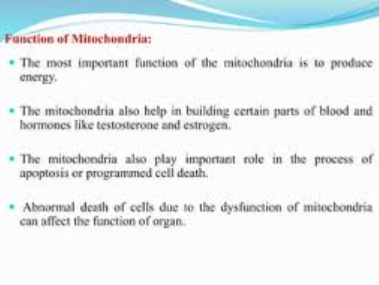Mitochondria structure and function
 In the intricate tapestry of life, there exists a small but mighty organelle that plays a central role in the functioning of eukaryotic cells. Mitochondria, often referred to as the “powerhouses of the cell,” are remarkable structures responsible for energy production, cellular metabolism, and a myriad of other essential processes. In this comprehensive article, we will delve into the world of mitochondria, exploring their structure, functions, significance in health and disease, and the fascinating evolutionary history that connects them to our distant ancestors.
In the intricate tapestry of life, there exists a small but mighty organelle that plays a central role in the functioning of eukaryotic cells. Mitochondria, often referred to as the “powerhouses of the cell,” are remarkable structures responsible for energy production, cellular metabolism, and a myriad of other essential processes. In this comprehensive article, we will delve into the world of mitochondria, exploring their structure, functions, significance in health and disease, and the fascinating evolutionary history that connects them to our distant ancestors.
The Anatomy of Mitochondria
Mitochondria are double-membraned organelles, which means they consist of two distinct lipid bilayers. These membranes enclose the various components that enable mitochondria to perform their vital functions. Let’s take a closer look at these components:
Outer Membrane: The outer membrane is porous, containing channels known as porins that allow the passage of ions, metabolites, and small molecules. This membrane separates the mitochondria from the cytoplasm of the cell.
Inner Membrane: The inner membrane is impermeable to most molecules due to its unique lipid composition and the presence of proteins known as transporters and enzymes. It houses the proteins responsible for the electron transport chain (ETC) and oxidative phosphorylation (OXPHOS), crucial processes in energy production.
Cristae: The inner membrane is extensively folded into structures called cristae, which increase its surface area. These folds house the machinery for ATP synthesis, the molecule that stores and transports energy within cells.
Matrix: The innermost compartment of the mitochondrion is the matrix, containing enzymes needed for the citric acid cycle (also known as the Krebs cycle) and fatty acid metabolism. It plays a vital role in the breakdown of nutrients to produce energy.
Functions of Mitochondria
Mitochondria are multifunctional organelles, and their primary role is to generate adenosine triphosphate (ATP), the cellular currency of energy. This process occurs through a series of intricate biochemical reactions known as cellular respiration, involving the citric acid cycle and the electron transport chain. Here are some key functions of mitochondria:
Energy Production: Mitochondria produce ATP by utilizing nutrients, such as glucose and fatty acids, through oxidative phosphorylation. This process is central to providing the energy needed for cellular activities.
Metabolism Regulation: Mitochondria are involved in regulating metabolism by controlling the breakdown of nutrients, maintaining cellular redox balance, and influencing the levels of reactive oxygen species (ROS).
Calcium Homeostasis: Mitochondria help maintain calcium ion levels within cells, which is crucial for various cellular processes, including muscle contraction and cell signaling.
Apoptosis: Mitochondria play a pivotal role in programmed cell death, or apoptosis, by releasing molecules that trigger cell death pathways when cellular damage or stress is severe.
Thermogenesis: In specialized brown adipose tissue, mitochondria have a unique role in thermogenesis, generating heat to regulate body temperature.
Mitochondria and Health
The health and proper functioning of mitochondria are integral to overall cellular health and, consequently, human health. Dysfunctional mitochondria have been linked to a variety of diseases and conditions, including neurodegenerative disorders (e.g., Parkinson’s and Alzheimer’s), cardiovascular diseases, metabolic disorders (e.g., diabetes), and even the aging process itself.
Mitochondrial DNA (mtDNA), a small, circular piece of genetic material located within mitochondria, is of particular importance. Mutations in mtDNA can lead to mitochondrial diseases, which often affect energy production and can result in a wide range of symptoms, from muscle weakness to organ failure.
Evolutionary Significance
Mitochondria have a fascinating evolutionary history that connects them to ancient bacteria. The endosymbiotic theory proposes that mitochondria originated from a symbiotic relationship between early eukaryotic cells and ancient aerobic bacteria. Over time, this partnership became mutually beneficial, with the host cell providing protection and nutrients while the bacterium contributed its energy-producing capabilities. This theory explains why mitochondria have their own DNA and replicate independently of the host cell.
Conclusion
Mitochondria are the unsung heroes within our cells, tirelessly producing energy and influencing cellular processes vital to life. Their intricate structure, functions, and connection to our evolutionary past make them a subject of ongoing research and fascination. Understanding mitochondria’s role in health and disease holds great promise for developing treatments and therapies that could impact a wide range of medical conditions. As we continue to unlock the secrets of these remarkable organelles, we uncover more about the intricacies of life itself.